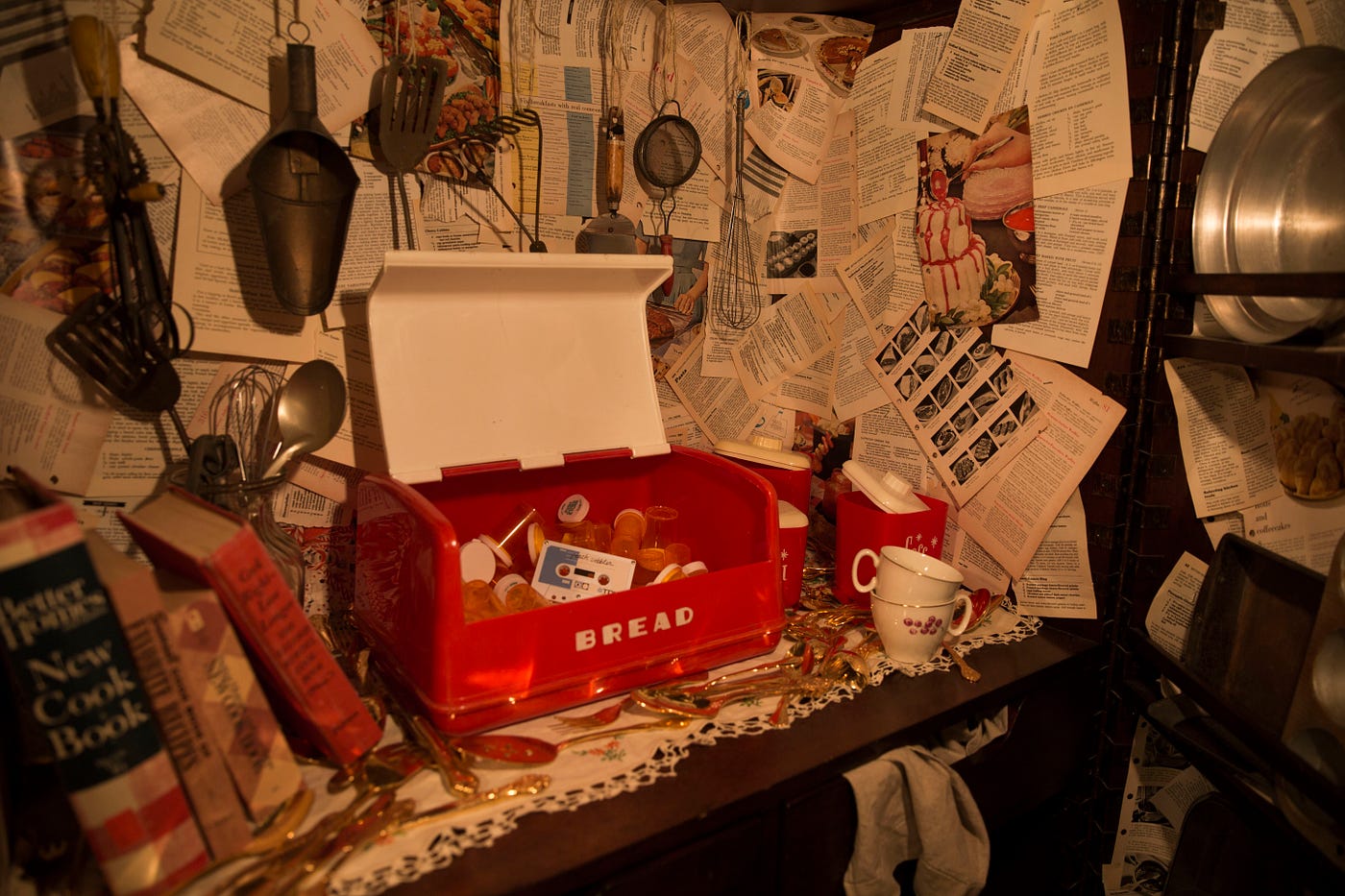
Stop me if you’ve heard this one before.
You’ve been trapped inside an office/apartment/woodshed by a renegade cop/serial killer/deranged wizard. He/she/the entire population of Mars have given you just sixty minutes to disarm the bomb/prove your innocence/find your car keys.
If you don’t, you and your friends will die.
This plot structure is to the wildly popular escape room phenomenon what the Joseph Campbell defined Hero’s Journey is to Hollywood storytellers: the ur-text from which a thousand attempts at greatness have been sprung. But for every Star Wars there have been nine hundred and ninety nine Snow White & The Huntsman… and while escape rooms haven’t worn out their welcome in the way that vapid special effects laden “blockbusters” have, the form’s potential as a vessel for truly moving stories has barely been tapped.
In a backyard in one of Los Angeles’ cozier neighborhoods that’s all starting to change.

Students of the Craft
The backyard in question belongs to Jeff Leinenveber, a Walt Disney Imagineer by day who, along with his fellow Imagineer Jarret Lantz, founded the new immersive company Scout Expedition Co. after years of collaboration and research. Indeed the road to The Nest, the duo’s first original work, is a downright methodical case study in how to design your own master class in immersive storytelling. Not shocking, perhaps, considering the rigors of design in the theme park industry.
Lantz and Leinenveber began their creative partnership designing events for their co-workers at WDI, but once the immersive bug has been caught there’s rarely any going back. Office events led them down the path to Jon Braver’s Delusion, where they were part of the design team, taking classes with Punchdrunk in London and leaping at an opportunity last year to work with Third Rail Projects on a bespoke event for Oculus, the pioneering virtual reality company.
It was at the latter that I first got a clear sense of what the as-yet-unnamed Scout team was capable of. As one of the performers in that piece told me, the pair showed up with a van full of stuff and within a half a day had a whole set put together inside an otherwise bare space.
Now that’s no strange feat in the land of film and television but the end result, which turned one space into three distinct points in time and space, felt as enchanted as something that had been meticulously designed over the course of months.

The Life of Josie
We’ve been at it for, it must be fifteen minutes now, although we have no real way of knowing. I’m holding the flashlight at this very moment, my companion working the combination lock that separates us from the next room, when it flickers out. Again. As if the gods themselves don’t want us to learn what happened to Josie, a distant relative for whom I appear to be the last known kin.
There’s no bomb. No lurking serial killer. There is, in a sense, a ghost. The traces of a life left behind in a series of audio cassettes and the space itself. The life of Josie, a woman whose story is embedded in the very walls around us.
“It’s been really hard for us to define what The Nest is,” Leinenveber tells me in an interview long after I’ve found my own answer to the question, “but yes, we definitely borrowed a few elements from escape rooms.
“Still though, we make it very clear to people in the introduction that this is not an escape room; the only ‘winning scenario’ is learning more about Josie’s story.”
Get Noah J Nelson’s stories in your inbox
Join Medium for free to get updates from this writer.
SubscribeSubscribe
That story unfolds through two means. First there is the layered visual design of Josie’s storage unit, which contains mementos from her life.
“We approach set design in the same method that a writer might approach a story: by first getting into the heads of the characters and understanding their motives,” said Lantz. “As soon as you slip into that mind space, everything begins to flow. In the case of ‘The Nest,’ the space is a physical manifestation of Josie’s memories, and therefore the layout is determined by how she would react to moments that happened in her life.”
Leinenveber picks up the thread.
“For example, we’ll physically sit at a desk we’re decorating, and imagine how Josie might have set up the space. She was a journalist, so the typewriter is front and center, and photos and notes of happy memories surround her workspace. On the other hand, if something was a painful memory she’d rather forget, it might be locked away in a trunk in the back of a hard to reach area.”
The second are the series of cassette tapes which tells her story in her own words, starting in childhood, and then winding through a series of vignettes in different periods. Neither epic nor supernatural, Josie’s story nevertheless enthralls through the emotional depths which that the creators are willing to go.
“Emotional depth” doesn’t usually leap to mind when the words “escape room” come up in casual conversation, but it might be surprising to note where the inspiration for taking this tack comes from.
“We were most directly inspired by our love of narrative-driven adventure videogames,” said Leinenveber, pointing to a recent renaissance in a genre that puts tone, feelings, and story back in the spotlight. “We combined a bit of story influence from Gone Home and Firewatch, puzzles like those of Myst, and the rich environments of the Bioshock series. In the end, although there are sometimes hints of sinister elements in Josie’s life, there are no monsters or doomsday scenarios… instead, it’s a relatable story about an everyday person.”
There’s also something of the long-form podcast mystery that was popularized by the show Serial about The Nest. Each cassette discovery becomes its own act in the drama, whether it is a solo narration by the adult Josie (played by Mackenzie Firgens), a scene with Josie’s husband Tom (The Speakeasy Society’s Matthew Bamberg-Johnson) or the handful of other characters explorers may or may not encounter. The tapes, and they really are tapes played on an old cassette deck that will send some into nostalgic reverie, allow for a non-linear telling of the story.
The Nest itself is designed so that it’s unlikely that anyone will discover all of Josie’s tapes, and yet triggering FOMO — that fear of missing out — is not the goal. Like Sleep No More and Then She Fell, the touchstones of immersive theatre, the story any given audience member walks away with is their version of Josie’s tale. It cuts against the grain of the completionist instinct that is honed by videogames, nudging the audience into a zen-like truth: we can only know so much of another person, no matter how diligently we dig.

Mastering The Lessons
What’s the secret to The Nest’s ephemeral beauty?
Is it the tight construction of the mini-dramas of the tapes? The meticulous construction of the environments, or the sometimes whimsical logic of the puzzles? What great lesson did the Scout team learn as they built their world from bits and bobs?
“Testing, testing, testing,” said Lantz.
“The biggest challenge with The Nest is that there aren’t any actors in the space to help guide the audience members through the story. Because of that, the design of everything needs to be so tight and intuitive that audience members can guide themselves through the story at the appropriate pace. To help us design, we learned that it was vital to bring friends — who knew nothing yet about the show — in at every stage of the design process to make sure that we were staying on target.”
“Through these continuous tests,” said Leinenveber, “we also learned not to hold anything too precious. Some parts of the story had to be simplified or even cut completely. Other major experience elements — including, without spoiling anything, something you find in an armoire — were added only a few days before the show… and now we can’t imagine how we lived without them. In short, we couldn’t fall in love with the design, and always had to remain completely flexible.”
More than design lessons were learned on this project. After emerging from The Nest it’s hard to accept that this is Scout Expedition Co.’s first show all on their own.
“We’d worked on pieces of many other immersive shows,” said Lantz, “but designing and producing our own from scratch taught us entirely new things — marketing, ticketing, audio design, stage management, just to name a few. Point is, if you’ve been considering doing an immersive show but aren’t convinced you know everything in order to pull it off, don’t worry… just start designing, and you’ll learn as you go!”
The response to the promise of The Nest was incredible in and of itself: with the experience selling out and extending barely before it had taken flight. Now only two real questions remain: how long can Lantz and Leinenveber keep this up — the piece does live in Leinenveber’s back yard, after all — and what comes next for the duo.
Because if this is where they’re starting out their careers as independent producers, the road ahead is full of promise.
For now: The Nest will be extending in June, with shows on select nights. Tickets return to sale May 4th at noon, Pacific, with a pre-sale for subscribers to Scout’s own newsletter.




















Discussion